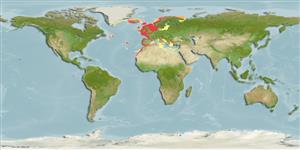Environment: milieu / climate zone / depth range / distribution range
Ekologi
marina; brackvatten bottenlevande; djupintervall 10 - 340 m (Ref. 56504), usually 10 - 150 m (Ref. 35388). Temperate; 71°N - 21°N, 49°W - 42°E
Eastern Atlantic: Norway to Morocco, Madeira, Iceland (Ref. 2723), including Greenland (Ref. 115160). Also known from the Mediterranean and Black Sea (Ref. 4697).
Length at first maturity / Size / Vikt / Age
Maturity: Lm 18.8, range 24 - ? cm
Max length : 60.0 cm TL hane/ej könsbestämd; (Ref. 3397); common length : 30.0 cm TL hane/ej könsbestämd; (Ref. 4697); publicerad maxvikt: 956.00 g (Ref. 41256)
Head large without deep occipital groove. Vertebrae 37-39 (11-13 precaudal and 25-27 caudal).
Common on sandy grounds, sometimes on rocky bottoms, and also on mud between coastline to 140 m depth. Up to depth of 340 m in the eastern Ionian Sea (Ref. 56504). Feeds on crustaceans, mostly shrimps and shore crabs; fishes, mostly gobies, flatfish, young herring and sand eels. Makes croaking sounds (Ref. 9987). Utilized fresh and frozen; eaten fried and baked (Ref. 9987).
The young are pelagic until attaining a length of 3 cm.
Bauchot, M.-L., 1987. Poissons osseux. p. 891-1421. In W. Fischer, M.L. Bauchot and M. Schneider (eds.) Fiches FAO d'identification pour les besoins de la pêche. (rev. 1). Méditerranée et mer Noire. Zone de pêche 37. Vol. II. Commission des Communautés Européennes and FAO, Rome. (Ref. 3397)
IUCN Red List Status (Ref. 130435)
Threat to humans
Harmless
Human uses
Fiskeri: kommersiell
Verktyg
Special reports
Download XML
Internet-källor
Estimates based on models
Preferred temperature (Ref.
123201): 7.3 - 13.5, mean 10.1 °C (based on 1378 cells).
Phylogenetic diversity index (Ref.
82804): PD
50 = 1.0000 [Uniqueness, from 0.5 = low to 2.0 = high].
Bayesian length-weight: a=0.00692 (0.00574 - 0.00834), b=3.04 (2.98 - 3.10), in cm total length, based on LWR estimates for this species (Ref.
93245).
Trofisk nivå (Ref.
69278): 3.9 ±0.0 se; based on diet studies.
Generation time: 6.9 ( na - na) years. Estimated as median ln(3)/K based on 1
growth studies.
Resiliens (Ref.
120179): Mellan, lägsta populationsfördubblingstid 1,4-4,4 år (K=0.16; tm=3-4; tmax=16; Fec=200,000).
Prior r = 0.74, 95% CL = 0.49 - 1.10, Based on 1 data-limited stock assessment.
Fishing Vulnerability (Ref.
59153): High vulnerability (55 of 100).
Climate Vulnerability (Ref.
125649): Low to moderate vulnerability (27 of 100).
Nutrients (Ref.
124155): Calcium = 42.8 [23.8, 88.7] mg/100g; Iron = 0.431 [0.232, 0.773] mg/100g; Protein = 17.6 [15.9, 19.4] %; Omega3 = 0.682 [0.312, 1.889] g/100g; Selenium = 21.1 [10.6, 47.8] μg/100g; VitaminA = 12.8 [4.8, 37.7] μg/100g; Zinc = 0.494 [0.355, 0.707] mg/100g (wet weight);
